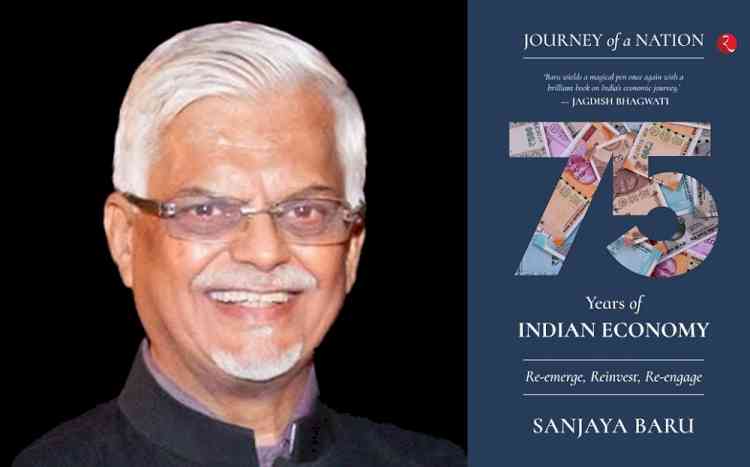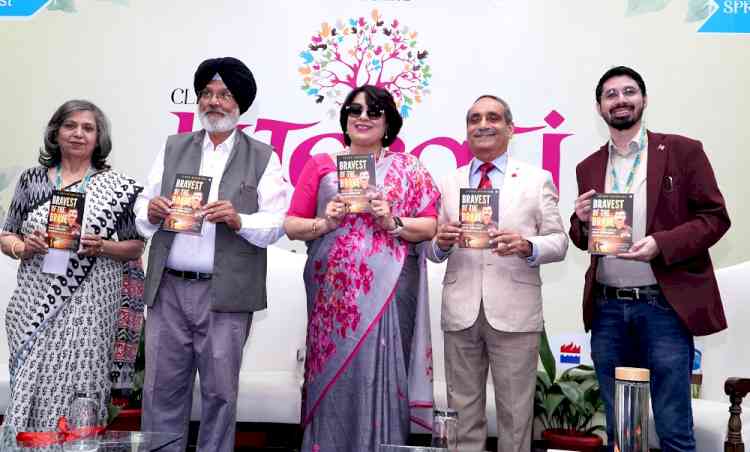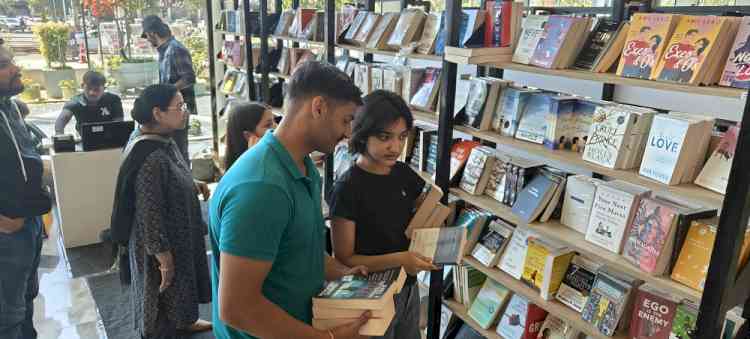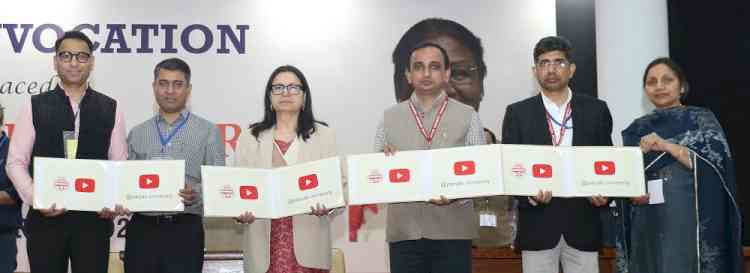Revival of growth, creating new employment opportunities remain a priority: Sanjaya Baru (Book Review)
The first two decades of the 21st century witnessed a significant transformation of Indias economy but the country entered the 75th year of Independence with "grave concerns" about poverty, unemployment, inflation and loss of global competitiveness, while the Covid-19 pandemic and the contingency measures it entailed "cast a long shadow" on economic growth even as we "already see the kind of changes" needed on the way forward, says a new book by political commentator and policy analyst Sanjaya Baru.

Vishnu Makhijani
New Delhi, Aug 6 (IANS) The first two decades of the 21st century witnessed a significant transformation of Indias economy but the country entered the 75th year of Independence with "grave concerns" about poverty, unemployment, inflation and loss of global competitiveness, while the Covid-19 pandemic and the contingency measures it entailed "cast a long shadow" on economic growth even as we "already see the kind of changes" needed on the way forward, says a new book by political commentator and policy analyst Sanjaya Baru.
"India entered the 75th year of Independence still carrying gave concerns about poverty, unemployment, inflation and loss of global competitiveness. Despite these setbacks, in terms of purchasing power parity, India is the world's third largest economy behind the United States and China. In US dollar terms, it is now the world's sixth largest economy behind the US, China, Japan, Germany and the United Kingdom," Baru, who was Prime Minster Manmohan Singh's media advisor from 2004 to 2008, writes in "75 Years of Indian Economy".
The book, published by Rupa under the broad title "Journey of a Nation" and subtitled "Re-emerge, Reinvest, Re-engage", says that while "the past does not offer a perfect roadmap to the future", the next 75 years "will be very different, and we already see the kind of changes we need to make to be able to make the journey forward so that we are able to ensure the well-being and livelihood security of all and unleash the creativity of every citizen of our democratic republic, irrespective of caste, class, religion or region".
"A revival of growth and the creation of new employment opportunities will remain a priority for any government," Baru, who has served as Associate Editor of The Economic Times and The Times of India, as the Secretary General of industry lobby FICCI and as Director for Geo-Economics and Strategy at London's International Institute of Strategic Studies, maintains.
Written for the millennial generation "who will live through most of the 21st century", the book traces the ideas and events that have shaped India's economic policy, transforming a feudal, agrarian economy into a modern, industrial and service-based one. Harkening to the role played by the drain of wealth under British colonial rule on nationalist thinking and post-Independence policy, Baru explains how Indian political and intellectual leaders influenced policy on agrarian relations, industrialisation and the creation of a knowledge-based economy. He also offers a ringside view of the historic 1991 reform programme and its role in defining India's development trajectory in the 21st century.
The "real contribution" of Prime Minister P.V. Narasimha Rao (1991-96), Baru writes, to economic reform and liberalisation "was his political management of a contentious process" with Finance Minister Manmohan Singh (later the Prime Minister from 2004-14) providing professional leadership to the reforms and Rao the political backing.
"Economic liberalisation did more than merely step up the rate of growth of the economy. It made it easier for new business groups across the country to grow. The licence-permit-quota raj (existing at the time) had, in fact, facilitated the growth of oligopolies and crony capitalists. Delicencing made it easier for new business groups, especially those based in new centres of industrial activity like Gujarat, Karnataka, Andhra Pradesh and Punjab-Haryana.
"The regional dispersal of business activity was an important motivator and consequence of economic liberalisation. Apart from the `children of reform', as Dr Manmohan Singh once called them, like Narayana Murthy and Azim Premji of the information technology services business, new business leaders like Anji Reddy in Andhra Pradesh, Baba Kalyani and Habil Khorakiwala in Maharashtra and Sunil Mittal in Delhi, entered the ranks of India's billionaires at the turn of the century," Baru writes.
While the liberalisation of industrial policy contributed to the emergence of new enterprises, the liberalisation of trade policy enabled India to create new relations of interdependence with the rest of the world, the author states, adding: "Over the decade 1991-2001, the share of trade in national income increased and so did India's share of world trade."
Interestingly, there was a regional shift in the pattern of trade with India's trade with the wider Asian region, including West Asia, Southeast Asia and South Asia, rising faster than its trade with the US and Europe. China rapidly emerged as a major trading partner, as did countries like the United Arab Emirates.
Narasimha Rao's `Look East Policy' had a tangible impact on India's trade investment links with the world, Baru writes.
Cut to the first two decades of the 21st century and the "significant transformation" of the economy.
"There was a perceptible reduction in poverty, a rapid spread of urbanisation and the establishment of a globally competent services economy. India led the world in the production of several agricultural commodities. However, the manufacturing sector remained a laggard, despite the launch of a new `manufacturing strategy' by the Manmohan Singh government in 2012 that was subsequently modified and relaunched as the Make in India and Atmanirbhar Bharat programmes by the Narendra Modi government," Baru explains.
However, "demonetisation of high-value currency notes in November 2016 destabilised the economy, and after 2018 (when, among others, the spectre of ballooning NPAs of banks emerged), new concerns have emerged on the economic front, including a decline in the rate of investment, continued stagnation in the share of manufacturing in the national income, and the loss of momentum in the export growth. To add to these concerns, the nationwide lockdown imposed in response to the Covid-19 pandemic and the uncertainty generated both by contingency measures and the pandemic itself has cast a long shadow on economic growth," Baru contends.
Added to this, attaining each of the 17 Sustainable Development Goals (SDGs) mandated by the UN General Assembly for 2030, including key objectives such as universal health care and education, climate action and social justice, "will remain important challenges in the near term", he adds.
Thus, India's principal challenge today is, in many ways, "not very different from the challenge it faced at the time of Independence, namely, to eliminate hunger, banish poverty, educate all its citizens and ensure that their healthcare needs are adequately met", Baru writes.
India might have graduated from the ranks of a `low-income' economy, according to the old classification of countries adopted by the World Bank, to being classified as a `low-middle income' economy but China, on the other hand, has moved up into the ranks of `upper-middle income' economies, he points out.
"India will certainly continue to rise, but it requires constant and conscious effort," Baru adds.
There is, however, a caveat to this.
"Expectations shape outcomes in a world of uncertainty. Expectations about the economy end up being self-fulfilling prophecies. If you expect tomorrow to be better than today, you take economic decisions that ensure tomorrow is indeed better. On the other hand, if one believes the future to be bleaker than the present, one ends up making decisions and choices that contribute to a less-than-satisfactory outcome.
"The policy changes of 1991altered the `state of expectations', so to speak, about where India was headed triggering positive expectations about future growth and stimulating private investment," Baru writes, adding: "All successive governments comprising different political parties walked the path set by the initiatives taken in 1991."
That seems to be the perfect formula for India to re-emerge, reinvest, and re-engage with the rest of the world.
(Vishnu Makhijani can be reached at [email protected])


 IANS
IANS 







